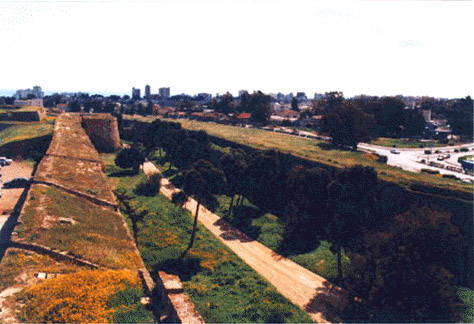|
 The old city of
Famagusta is encircled by the historical walls, which are massive and on
average are 60 feet high and 30 feet thick and date back to mediaeval times. The walls stand intact to this day, well preserved. The old city of
Famagusta is encircled by the historical walls, which are massive and on
average are 60 feet high and 30 feet thick and date back to mediaeval times. The walls stand intact to this day, well preserved.
The city walls built by
the Lusignans were very high but thin. After the
Venetians captured the
island from the Lusignans,
they brought over specialists from Venice to fortify the walls against
artillery fire particularly to protect themselves from the
Ottomans.
 Two of the original gates of the
Famagusta Castle, (the walls) still stand: Porta
del Mare (The Sea Gate), and Ravalin / Akkule Bastion (The Land
Gate). Two more gates have been opened during the British
period, which are the Djanboulat Gate, and the New Gate. Two of the original gates of the
Famagusta Castle, (the walls) still stand: Porta
del Mare (The Sea Gate), and Ravalin / Akkule Bastion (The Land
Gate). Two more gates have been opened during the British
period, which are the Djanboulat Gate, and the New Gate.
The wall on the sea
front, the Mantinengo bastion and the Ravelin (Land Gate) were modified
during the period. A ditch 46 metres wide was dug on the outer flanks of
the wall and was filled with water. The wall built of ashlar is 3
kilometres in length and reaches 9 metres in width at some points.
The city walls have bastions,
gates, ramps, embrasures, arms depots, depots and stables. Please click on the
map to see these indicated: 
The towers and bastions of the
walls are as follows:
- Arsenale (Canbulat)
- Porta
del Mare (The Sea Gate
Bastion)
- Castello (The
Othello tower)
- Stadonna (The Ringed
Embrasure)
- Diamante (The Karpas
Bastion)
- Mezzo (The Martyr
Bastion)
- Martinengo
- Pulacazaro
- Moratto
- Diocare
- Rivellino
(The White Tower)
- Porta
di Limisso (The Land Gate)
- Santa Napa (The
Golden Bastion)
- Andruzzi (The water
bastion)
- Camposanto (The
Ringed Bastion).
There is also the Othello
tower as an interior castle as part of the walls.
|









